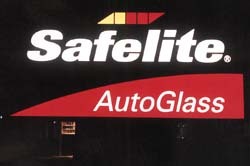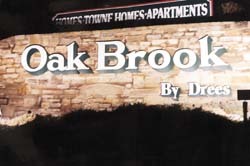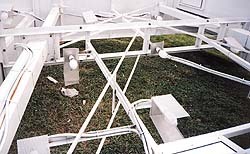LEDs + Lighting
The Lighting Lab
Signshops can be lighting pioneers
Published
18 years agoon

Sign lighting remains an experimental science. This is clear from observing the odd appearances of various electric signs after dark. If you think the technical departments of large lamp manufacturers are storehouses of sign-specific information, think again. Light-bulb makers are primarily concerned with residential and commercial area-lighting applications, not signs. Lighting specifications for kitchens, offices and parking lots may be standardized, but the official "sign-lighting book" has yet to be written. Lamp manufacturers continually introduce new, more efficient products, but it’s up to sign companies to determine the ultimate suitability of these products.
Because signs represent special lighting applications, sign builders must create appropriate, custom-lighting schemes for each type of product. This process must incorporate the technical specifications that lamp manufacturers provide, such as color temperature, color rendering index (CRI), lumen output and wattage. But signage applications introduce many variables to the equation as well. These include the sizes and depths of sign cabinets, and the effects of specific light sources on various translucent sign-face colors. Hence, when a large sign manufacturer develops a prototype for a national identity program (Fig. 1), determining the final lighting arrangement typically involves a substantial amount of trial and error. It’s easy to predict lighting effects in open areas, but not when lamps are enclosed in a sign cabinet.
Lighting types
seven varieties of general-purpose lamps. Incandescent lamps are still used for some externally illuminated signs. These lamps produce warm, inviting light with excellent color-rendering characteristics. But the major drawbacks of incandescent bulbs are short lamp life and high energy-consumption. Therefore, if 150-watt, incandescent floodlights are used to illuminate an MDO signboard, the owner will invest more time and money replacing burned-out bulbs, in addition to receiving a higher electric bill. For this reason, the percentage of signs illuminated with incandescent lighting has declined steadily over the past 50 years.
Tungsten halogen lamps are widely used in retail-store lighting, but their use in signage applications has declined in recent years. Still, sign companies sometimes use the long, clear, tubular variety of this lamp, commonly called a "quartz bulb." Tungsten halogen lamps are similar in color temperature and CRI to standard incandescent lamps. These lamps are slightly more efficient than standard incandescent bulbs. Tungsten halogen lamps also have a relatively short life span, and they must be handled carefully to prevent premature failure. Because the lamps are available in 300-, 500-, 1,000- and 1,500-watt sizes, they are frequently used in enclosed fixtures as floodlights for signboards, billboards and architectural signs (Fig. 2).
Fluorescent lamps are, by far, the most common type of sign lighting because they combine efficiency with high CRI ratings. Also, a wide range of color temperatures (measured in Kelvins) is available. By varying the phosphor coatings on the inner walls of the tubes, fluorescent lamps can be produced in several colors. National retailers commonly specify particular fluorescent-lamp colors for their identification signs.
The warmest fluorescent-lamp color typically used for sign lighting is "Cool White" (4,150K). "Sign White" (5,200K) lamps represent a mid-range choice, and "Daylight" (6,250K) lamps are the coolest color. The subjective terms "warm" and "cool" refer to the psychological effect of the light. In general, a "warmer" lamp emits a more yellowish light that renders flesh tones well. As the color-temperature rating increases, a "cooler" lighting effect is produced, and the light appears whiter. Cool lamp colors are quite effective for rendering various colors on translucent sign faces, but human faces take on pallid appearances in this light.
Because the brightness of an internally illuminated sign depends on the number of lamps used, their spacing and the depth of the sign cabinet, your best guide for proper illumination is to examine the layouts of national-program signs stored at local "sign graveyards." If you’re a newcomer to the sign-building game, contact a local signshop that keeps old signs in storage, and inspect their stock. Observe various lamp arrays and note the lamp-spacing in relation to the cabinet’s depth. Also, note the techniques that quantity builders use to overcome internal shadowing or "hot spot" problems. For example, some large signs have adjacent banks of horizontal lamps that overlap in the center (Fig. 3). This overlap causes a noticeable bright spot when the sign is illuminated. To correct this problem, the builder installs metal shields around the overlapping portions of one bank of lamps.
High Intensity Discharge (HID) lamps have become the most popular substitute for fluorescent lamps in large electric signs. Because mercury-vapor lamps were introduced before metal-halide lamps, HID lighting initially got the undeserved reputation of being unsuitable for signs. Mercury vapor lamps have low CRI ratings because they emit light that adds a blue-green cast to sign-face colors. The effects of this coloration can be mitigated somewhat by using white (coated) mercury lamps instead of clear lamps.
Metal-halide lamps, however, have much better color-rendering capabilities than mercury lamps. Although standard metal-halide lamps are rated at an acceptable level of 65-70 CRI, some of the latest types developed for retail-store lighting are rated as high as 96 CRI. Available in colors of 3,500-6,500K, these lamps cover approximately the same lighting range as fluorescent bulbs. Because metal-halide lamps emit very intense light, however, metal light-diffusers must be installed around each lamp to produce uniform illumination of signs (Fig. 4).
The principal advantages of HID lamps are efficiency and long life. By increasing the sign cabinet’s depth and incorporating diffusers, very large signs can be illuminated with only a fraction of the number of lamps required for fluorescent lighting. Also, because each HID lamp socket requires only a two-wire feed from the ballast, the number of secondary wires and connections is substantially reduced. Troubleshooting and maintenance of HID signs, therefore, is much simpler. This is an important advantage for high-rise signs and other large signs installed in difficult-to-service locations.
In the past, high-pressure sodium (HPS) lamps have been suitable only for lighting certain architectural and rustic-theme signs. The typical CRI rating for these lamps (20-22) is not high enough to render colors effectively. In general, this characteristic made HPS lamps appropriate only for externally illuminated signs with dominant white, yellow or brown colors. But recently, lamp manufacturers have introduced HPS lamps with CRI ratings of 70-82. Because the HPS lamp is more efficient than any other type of bulb, this development might have important ramifications for the future of sign lighting.
Compact Fluorescent Lamps
If you visit your local home-improvements store, you’ll notice some exotic, energy-saving light bulbs for sale. Compact fluorescent lamps are considerably more expensive than standard incandescent bulbs. But this substantial difference in initial cost is deceiving. For example, a 14-watt compact fluorescent bulb outputs 80 percent of the light emitted by a 60-watt, incandescent light bulb. In addition, the compact fluorescent lamp lasts nine times as long as the incandescent bulb. Manufacturers estimate that the annual energy savings realized by substituting a 14-watt compact fluorescent bulb in this application is $40.30 (based on continuous, 24-hour-per-day operation).
At present, two obstacles prevent this new generation of lamps from finding widespread sign applications. The first roadblock is that these lamps are not currently designed for use inside enclosed fixtures. Second, the lamp’s minimum starting temperature is 32 degrees Fahrenheit, not low enough for outdoor, cold-weather use. But experience has shown that, once manufacturers discover the needs of specialized lamp markets, they make the necessary engineering improvements. For example, G.E. Lighting (Cleveland) currently offers a 39-watt, compact-fluorescent lamp that provides approximately the same light as a 150-watt bulb, with a starting temperature of 0 degrees Fahrenheit. Like standard fluorescent lamps, compact-fluorescent bulbs are available in a wide range of color-temperatures for various applications.
As development of compact-fluorescent lamps continues, sign companies can anticipate the day when most signs will be illuminated by screw-in or plug-in bulbs that don’t require separate ballasts. Operating costs will be substantially lower than today’s standard, high-output, fluorescent lamps. But the "lighting labs" that will experiment with these new lamps also serve as high-production sign-fabrication shops. Hence, full-time research simply isn’t possible. Consequently, we can anticipate a substantial time lag before some of the latest lighting technology finds its way from general lighting applications into the sign-business mainstream.
Lighting tests
After checking the manufacturer’s specifications to determine if a particular lamp is suitable for signage use, the sign builder experiments with various lamp arrays and colors to obtain optimum lighting effects. For example, because a wide variety of metal diffusers is used with HID lamps, obtaining adequate, uniform lighting typically requires numerous trials. To eliminate shadows or bright spots, additional alterations might be necessary.
By necessity, sign professionals will continue to be lighting pioneers. Only by examining other successful products, and by gaining hands-on design experience, can sign builders become proficient in the art of light.
| Lamp Efficiency, Color and Durability | ||||
| Type | Lumens per Watt (LPW) | Color Temp | CRI | Average Life (hours) |
| Incandescent | 5-22 | 2,750-3,400K | 95-100 | 750-2,000 |
| Tungsten Halogen | 12-36 | 2,850-3,000K | 95-100 | 2,000-5,000 |
| Compact Fluorescent | 27-80 | 2,800-6,250K | 80-85 | 9,000-10,000 |
| Fluorescent | 75-100 | 2,700-6,300K | 48-90 | 12,000-24,000+ |
| Mercury Vapor | 50-60 | 3,300-5,900K | 22-52 | 12,000-24,000+ |
| Metal Halide | 80-115 | 3,000-6,500K | 65-96 | 10,000-20,000 |
| High-Pressure Sodium | 90-140 | 2,000-2,500K | 20-82* | 10,000-24,000+ |
| * Lamp manufacturers have recently introduced HPS lamps with improved CRI ratings. | ||||































